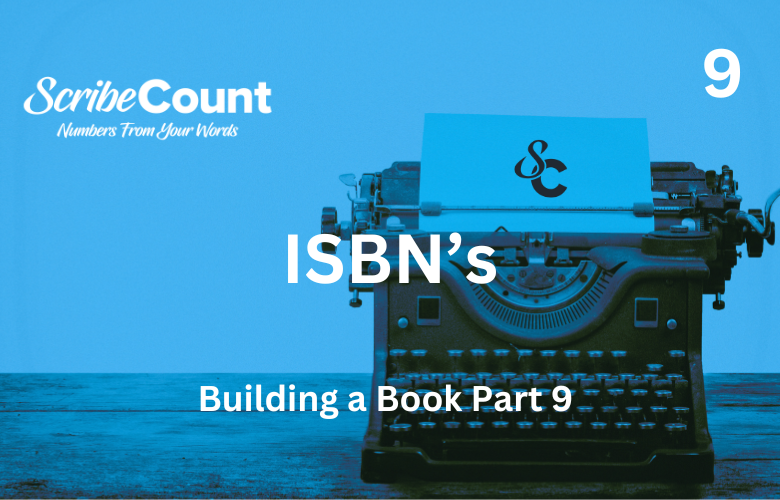ISBN’s
There are few subjects more confusing to new indie authors than the ISBN.
Much of the confusion is related to whether or not you need them, so lets answer that question first.
When it comes to ISBN's its important to remember one thing: ISBN's relate to FORMAT.
Not edition.
Not changes in the backmatter, cover art, or blurb.
FORMAT.
It helps if you place yourself in the bookstore owners shoes. If you were to enter their store and ask for a book, the first thing he would likely ask is "Paperback or Hardcover?"
The paperback has one ISBN, the hardcover has another. The same is true for ebooks, large print books, audio, braille, CD's, translations, etc. If you ask him to order you a copy of that book in braille he is going to do so using the ISBN specifically for the braille format of that book. If you want the box-set for a series he's going to use the specific ISBN for that boxset. If you want the Spanish version he's going to use the ISBN for the Spanish version. When you have exited the store and he gets on his computer to order a replacement copy for the book you just bought he's going to do so by entering the books ISBN into the ordering system.
Still the same book in all cases, its just in a different form...at. Get it?
You will need a separate ISBN for each format of a book that you intend to publish it in.
First-things-first; what does ISBN stand for?
ISBN stands for International Standard Book Number. It’s a number used by libraries, publishers, book dealers, online retailers, wholesalers, marketing services, and printers to not only identify your book but also which version of your book exists in their databases.
When you buy a book in a traditional bookstore, and the seller scans the barcode at the register, it tells the store more than just how much to charge you. A mountain of information comes with that little beep. The same thing happens when you click your mouse in an online store. The flow of information triggering the purchase process starts with that ISBN.
This is crucial when ordering a book online or from any of the places just mentioned. Having the proper ISBN is what tells the seller's computer the version of your book the customer has ordered, the language they wish to read it in, and the format in which they wish to read it. That little 13-digit code is used to uniquely identify your book, instantly separating it from the millions of others out there.
You can tell a lot about a book and its author just by reading the ISBN number and the barcode that goes with it. This is data about you and your publishing business. As we’ve discussed in previous posts, when it comes to your business you want to have as much control as you can. Giving up that control is giving up the leverage that comes with it. Controlling the data that is literally branded onto your product is important. Your company should own your books ISBN’s the same way it owns your copyright, publishing name, pen name, or domain name. Owning your ISBN gives you control over the data attached to it. Having that control gives you leverage. Leverage is what you use to generate sales and keep more of the money you earn.
“But I’m told that I don’t need an ISBN at all, or that I can get one free from my aggregator? Why do I need to buy my own?”
There are several reasons that you should own your own ISBN’s.
If you are only selling ebooks, and only at Amazon, then yes, you do not need an ISBN. But by limiting your sales this way you may be leaving a lot of money on the table.
If you use a “free” ISBN from your aggregator, it can only be used at that aggregator. You cannot use an ISBN given to you by Draft2Digital for example, at another platform. If you were to try and use it somewhere else the platform would not except it. You would have to acquire another “free” ISBN from the second platform, and another from the third, and so on until you were juggling multiple ISBN’s all attached to the same book.
This is bad enough, but remember, ISBN’s are data. Data about your book and your publishing company. If you use a “free” ISBN provided by an aggregator, that aggregator will be listed as the publisher of your book as they own the ISBN. They will also control the data that is attached to it. If they mislabel your Horror novel as Romance it’s safe to say that it will affect your sales. And worse yet, you may not even realize it happened. Getting it changed can be a nightmare.
Last but not least, without your own ISBN stores may refuse to stock your book on their shelves. Most bookstores get their products from wholesalers and those wholesalers computer systems utilize the ISBN to place orders. If your book is not in their system it is highly unlikely they will be willing to carry it. The extra labor involved to order, stock, and track your book is just not worth it. For a bookstore to carry your book on their shelves it must be easily accessible from established systems, set at the right discount, and readily returnable, or the stores simply won’t want to deal with you.
That all starts with an ISBN.
So, how do they work?
A books ISBN is usually found in the lower right-hand corner of the back cover. It’s the number sitting on top of the barcode. (ISBN’s and Barcodes go hand-in-hand, but let's talk about the ISBN first.)
The 13-digit ISBN number tells us:
- the specific title
- the author
- the type of book they are buying (genre)
- the physical properties of that particular book (Paperback, Hardcover, Audio, etc)
- the geographical location of the publisher (Country of origin)
What do all these numbers mean?
A lot actually. Let’s break it down here.
Here is the ISBN for a particular book:
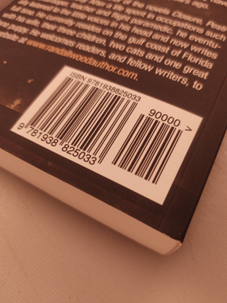
You’ll notice there are two barcodes. The larger one on the left is the ISBN. Let’s focus on that first.
978-1-93-882503-3
The sequence is divided into five separate number codes.
The first three digits “978” indicates that this string of numbers is for an ISBN. Those first three numbers will only change when every combination of the following numbers has been exhausted. So let’s focus on the remaining ten numbers.
978-1-93-882503-3
First is the initial digit, in this case: 1
This number is the language group identifier and they range from 1 to 5. For English-speaking countries either a 0 or a 1 is used. 2 = French. 3 = German. 4 = Japanese. 5 = Russian. And so on.
You can find the complete list of these codes at the International ISBN Agency.
978-1-93-882503-3
The next number in the sequence is 93. This number is the publisher code. It can be up to
nine digits long and serves to identify the publisher on every book that has
it.
978-1-93-882503-3
“882503” — This six-digit series represents both the title of the book and the specific format the book comes in. This number identifies whether the book is a Hardcover, a Paperback, Large Print, Audio, or whatever format is available.
978-1-93-882503-3
“3” is the last digit and is always a single digit. This number is referred to as a “check digit” and is mathematically calculated as a fixed digit. The software that produces the Barcode automatically calculates this for you so that an incorrect check digit can’t be used (thereby rendering an invalid barcode). If you enter the wrong check digit, the Barcode software will ignore your incorrect input and enter the correct check digit. This number indicates that the rest of the ISBN numbers have been scanned and is then calculated based on the other digits in the code.
You can also verify the correct check digit using GS1’s check digit calculator.
ISBN’s and Barcodes.
As we mentioned earlier, the ISBN is almost always accompanied by a barcode. Two of them actually. One larger one represents the ISBN itself, and a smaller one, usually to the right, that contains additional information.
While the two numbers are found together, they are not the same. The ISBN, once assigned, will be locked in and never change, while the smaller barcode is quite flexible. This smaller barcode allows the retailer to scan and assign your books price and the currency that its being sold in. This helps them keep inventory, track sales, and change pricing as needed. The standard barcode is known as the EAN (European Article Number) barcode, and most bookstores require it to be in this format before they will carry it.
The barcode can represent a price determined by the publisher, or it can be generic and left up to the bookstore itself to choose a price. Example: A barcode of 51599 indicates a price of $15.99, while a code of 90000 is left open for assignment by the store.
So how many ISBNs should you get?
You need an ISBN for every specific format of the book you are publishing. The common formats used today are many.
· E-book
· Paperback (there are 30+ different paperback sizes, you’ll need an ISBN for each size)
· Hardcover (14+ sizes)
· Audio (Digital)
· Audio (Physical)
· Large Print (Usually in hardcover, but can be done in paperback)
· Box Sets
· Translations (You’ll need an ISBN for each language and format that language comes in)
There are a slew of other less commonly used formats as well. Braille, Comic Book, Magazine, PDF, etc. Depending on the story you wrote and the audience it was written for, you may have several formats beyond what is considered the norm.
NOTE: You won’t need an ISBN to sell in each individual country unless that requires a different language. You can publish your English language novel in the US, UK, Australia, and New Zealand without changing the ISBN number. While ISBNs are international, they are assigned locally. If you are a US-based publisher you can purchase their ISBNs through Bowker and sell that book worldwide using those ISBNs.
When you assign an ISBN to a book it is locked-in. It cannot be pulled from that book and re-used for another. If the book is taken out of print the ISBN is simply made dormant and no longer used. It can’t be used with any other book in the future, not even second versions of the same book.
TIP: If you create a series of books you can’t use the same ISBN for them. You can however use what's known as an ISSN or International Standard Series Number. These are assigned by the Library of Congress to designate books in a series. While many fiction and nonfiction authors have an ISSN number assigned to their book series, each book in the series will still require its own individual ISBN.
Where to obtain an ISBN:
- Australia – Commercial Library Services Agency Thorpe-Bowker
- Brazil – National Library of Brazil (Up to 28 February 2020)
- Brazil – Câmara Brasileira do Livro (From 1 March 2020)
- Canada – English Library and Archives Canada, a government agency; French Bibliothèque et Archives nationales du Québec
- Colombia – Cámara Colombiana del Libro, an NGO
- Hong Kong – Books Registration Office (BRO), under the Hong Kong Public Libraries
- India – Raja Rammohun Roy National Agency for ISBN (Book Promotion and Copyright Division), under Department of Higher Education, a constituent of the Ministry of Human Resource Development
- Iceland – Landsbókasafn (National and University Library of Iceland)
- Israel – Israel Center for Libraries
- Italy – EDISER srl, owned by Associazione Italiana Editori (Italian Publishers Association)
- Maldives – National Bureau of Classification (NBC)
- Malta – National Book Council (Maltese: Il-Kunsill Nazzjonali tal-Ktieb)
- Morocco – National Library of Morocco
- New Zealand – National Library of New Zealand
- Pakistan – National Library of Pakistan
- Philippines – National Library of the Philippines;[33]
- South Africa – National Library of South Africa
- Spain – Spanish ISBN Agency – Agencia del ISBN
- Turkey – General Directorate of Libraries and Publications, a branch of the Ministry of Culture
- United Kingdom and Republic of Ireland -Nielsen Book Services Ltd, part of Nielsen Holdings N.V.
- United States – R. R. Bowker
Each country has its own requirements and pricing. For this post we’ll focus on obtaining an ISBN in the United States.
R. R. Bowker.
In most countries, ISBN’s are free or very low cost to the authors and publishers in need of them. This is not the case in the United States. In the US a company by the name of Bowker has a monopoly on issuing and registering ISBN’s.
From the Bowker website:
“Bowker is the official ISBN Agency for publishers physically located in the United States and its territories (Puerto Rico, Guam, US Virgin Islands, Northern Mariana Islands, American Samoa, as well as military bases and embassies). If an ISBN is obtained from a source other than the official ISBN Agency, it might not identify the publisher of the title accurately. This can have implications for doing business in the publishing industry supply chain.”
Since they have no competition, and the government has granted them their monopoly status, Bowker can charge whatever they wish. While ISBN’s are computer-generated numbers and the database needed to store and manage these numbers is likewise low-cost. Despite this, Bowker charges several times what other countries do.
Unfortunately, if you are in the US you have no choice but to use them.
A single ISBN from Bowker costs $125. The prices come down the more you purchase yet remains outrageously expensive when compared to other countries. Each publisher will need to forecast the number of formats they wish to publish in carefully before deciding on how many to buy. The bulk prices are as follows:
- 10 $295
- 100 $575
- 1000 $1,500
Bowker also offers package deals that include Barcodes and QR codes. It's advised to steer away from these as the internet is well-stocked with FREE barcode and QR code generators that you can use to make your own. Most publishing plaforms will generate a barcode automatically when you upload your ISBN. All you need from Bowker is the ISBN and access to the Bowker’s database that comes with it.
Obviously, buying in bulk is cheaper. 1000 ISBN’s at $1,500 drives the cost down from $125 to $1.50 per number. ISBN’s are a business expense, so you’ll recoup a percentage of that expense when it's written off on your taxes, which will drive the price down even further.
100, or even 1000, ISBN’s seems like a lot. But when you factor in the multiple formats and markets that you can sell your book in that number gets smaller. If you plan on selling in 10 formats per book than 100 ISBN’s will be enough for ten books. 1000 will be enough for a hundred books, enough to last the typical author their entire career.
Bowker has raised their prices in the past and, since they have monopoly status, will likely do so again. An investment in ISBN’s today may save your publishing business money in the long run.
The upside is that ISBN’s never expire. You can purchase them today and bank them up for years to come. You can register titles years after you have purchased the ISBN’s for them.
Understanding why ISBN’s are important to your business is key. They supply the leverage needed to get your books into multiple markets that you would be unable to enter without them. The costs are high for new authors on a budget, but this is one of those situations where you really have no other choice. “The costs of doing business” as it is often said. It helps to think of ISBN’s as an investment in the life-long success of your company.
So how do I start the process?
Go here:
If you click on the link you’ll be taken to the R.R. Bowker ISBN website page. Look for the pink box on the right side of the page.
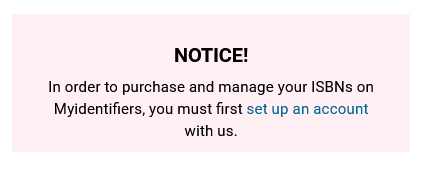
You can set up an account now, or do so later after you have selected your ISBN package and placed it in your cart. The checkout process will force you to register and create an account before you can complete the purchase.
If you’d rather do some reading first this page explains the reasons why you need an ISBN and lists the packages available. Again, we advise that you avoid the packages listed at the bottom of the page selling ISBN/Barcode combos, and focus instead on the right-hand side of the page where they list the offers for ISBN’s only.
Note how it says that the 10 ISBN package for $295 is the “best value”. That’s $29.50 per ISBN. Simple math tells us it is in fact the worst value. The 1000 ISBN’s for $1,500 package is the best value at $1.50 per ISBN.
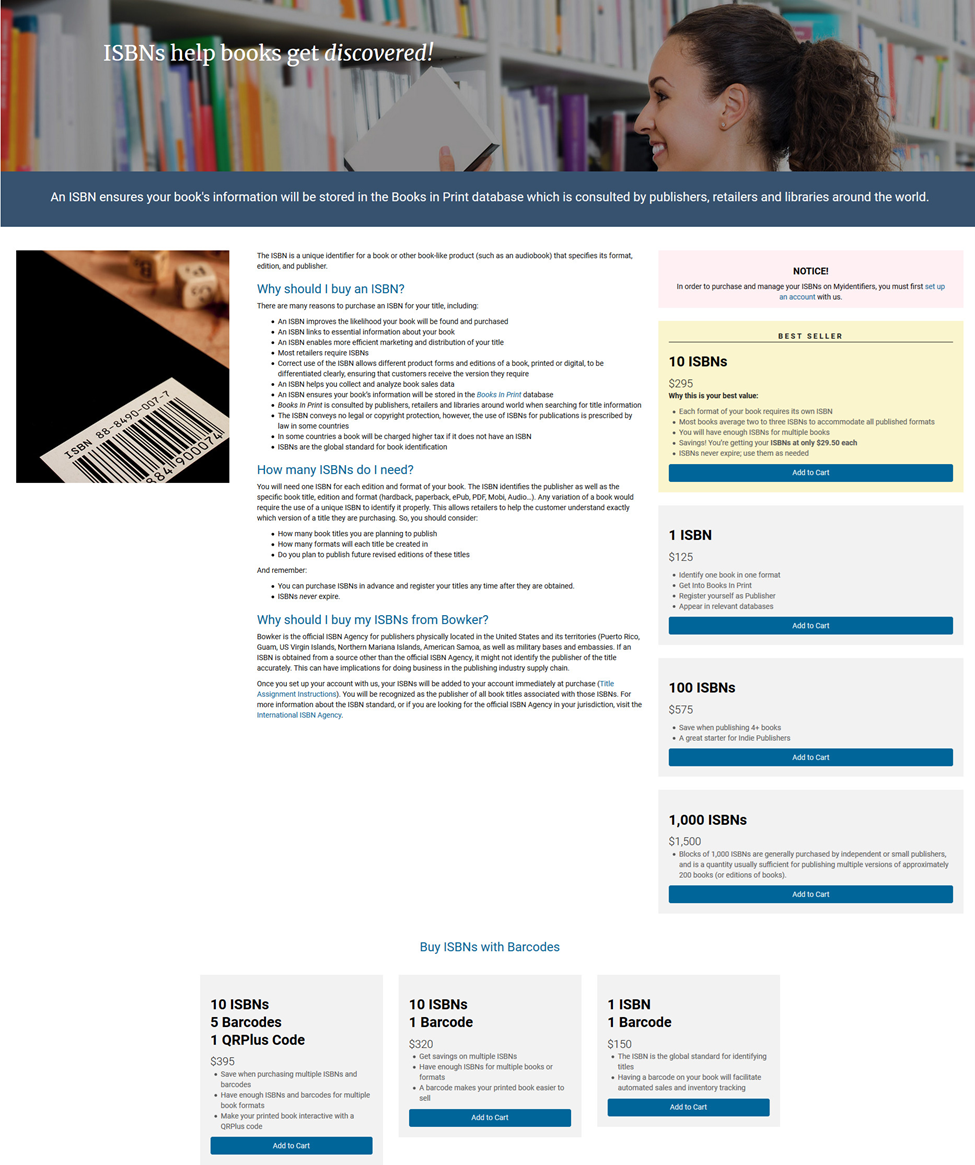
Select which package you can best afford and click the blue “Add to cart” bar beneath it. That will take you to this pop-up:
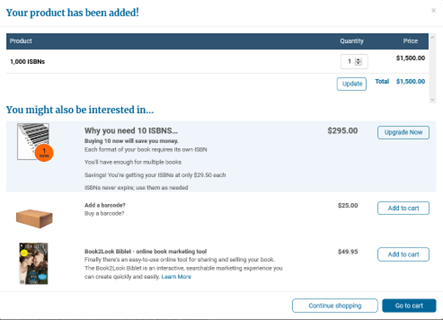
Again, more expensive packages that you can get for free elsewhere. To get your ISBN’s click the blue “Go to cart” button. (This may take you back to the previous page in an attempt to sell you more stuff, if so just click on the selection again) You should end up here:

This is a simple shopping cart page that will look familiar to anyone who has shopped online. Click the green “Checkout” button. If you haven’t made an account with Bowker yet you’ll be taken to this page:

Here you’ll create the account that your ISBN’s will be assigned and managed with. Simply create a Username and Password and then click the blue “Register” button.

You’ll be asked if you are a new customer or a returning one. Click “I am a new Bowker Customer”.
Fill out the form.
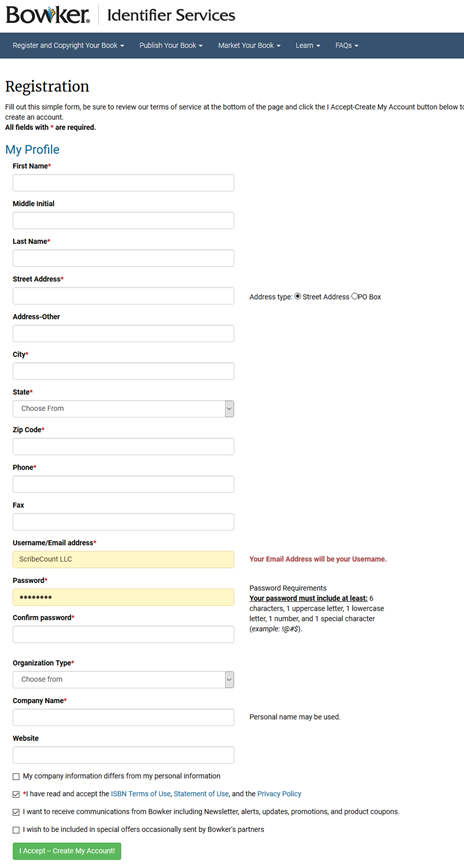
TIP: This form will attempt to autofill if allowed. Be sure to double-check that the autofill contains the information you wish it to before moving on.
Note: Only the boxes marked with a red asterisk (*) are required. There are also boxes at the bottom that are pre-selected for you. The first box will not apply if you are buying your ISBN’s in your name and not your company’s name. The second box is mandatory. The third and fourth boxes give Bowker permission to flood (and I mean FLOOD) your inbox with marketing.
Once completed, double-check that all the mandatory boxes are filled out and click the green “I accept-Create my account” button at the bottom. It should take you here:

At this point, you will find yourself back to the Sales page where you started. Only this time you will see your name in the upper right corner, along with a banner (in green) telling you that you have successfully created your account.
You’ll also have the ISBN package you selected earlier in the little shopping cart symbol in the upper right-hand corner.
Click on the blue shopping cart. It will take you here:

If the selection and quantity you selected is accurate, click the green “Checkout” button.
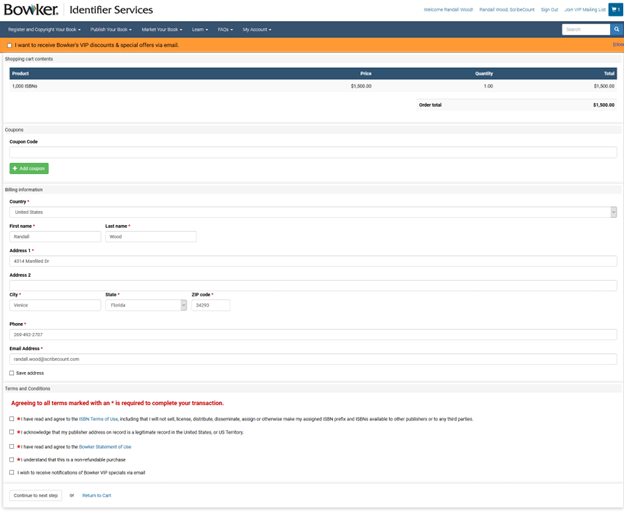
This is nothing more than a review page to verify your information and make another attempt to add your email to their marketing list. Again, be sure to fill out or check every box with a red asterisk and opt out of the marketing if you so desire.
Click on “Continue to next step”.
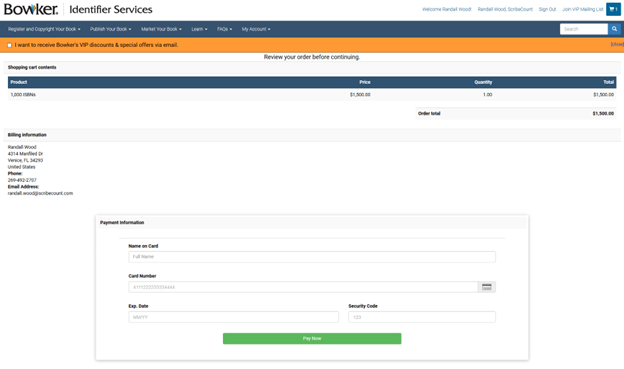
This takes you to Bowker’s payment processing page. It’s a simple Credit Card form. However, Bowker does not list the credit cards that they accept, so it's trial and error to find one that they will.
Once you have successfully filled out he payment information, click the green “Pay Now” button.
You should receive an email verifying your purchase.
Once you have your account and your ISBN’s you can assign them to your books. There is no required method of assigning numbers to your books. Many suggest that you make a list of every format you are selling your books in and break your list up into groups for each book. Some you may have already made, some you may plan on having in the future. Or you can just assign books a number as you publish them, it’s entirely up to you.
One thing Bowker does well is describe their interface and how to use it. This PDF walks you through the process so well we chose to simply link to it.
Before you go there, it's good to know a few things.
You’ll need the following information about your books:
- Title
- Subtitle
- Main Description (Blurb)
- Language
- If a translation, the translation title
- Copyright Date
- Publication Date
- Selling price
- Primary subject of the publication (genre)
- Format* (E-book, paperback, hardcover, etc)
*Format includes everything. The size. The number of pages. The length, width, and height of the book. It’s weight. The font size.
- Contributors (i.e., author/publisher)
- Cover Image (Jpeg only)
- The full manuscript. (PDF only)
- An author biography.
- Which edition or volume number.
- Where the book will be sold.
- The target age group.
Not all of these items are mandatory, but the more of them you fill out the more information you give the booksellers about your book and that is to your advantage. Much of this information is what you will want to include in your Sell Sheet, which we will cover later.
If you have questions about any of the steps, Bowker provides an explanation with each. Simply click on the little question mark next to each step and they will give you a short paragraph describing what is needed.
Once you have entered all the information Bowker provides a way to check it.
- Go back to your My Account logbook.
- When reviewing your title name, you should see a yellow circle with a black triangle to the left of your title name. This means that your title has been successfully processed.
- The yellow circle with a black triangle will change to a green circle the next business day.
- If the information is NOT complete, you will see a red circle next to the ISBN. Click on the red circle and it will tell you what you need to add or change.
What’s next?
Once you have successfully registered a title it still takes several business days before it is added to Bowkers “Books In Print” database. You will still be able to view all of the information you entered into your account while the registration is being processed.
It's suggested that you give Bowker at least fourteen business days before checking to see if your ISBN has been properly attached to your book. You do so here: ISBNSearch.org.
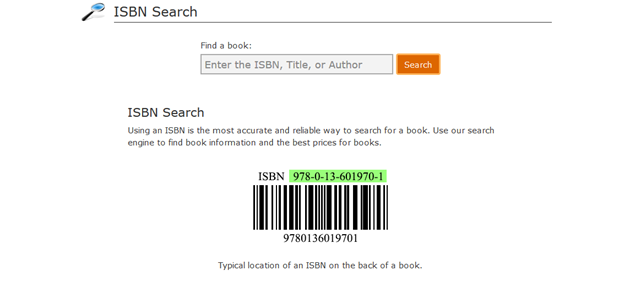
Type
in the ISBN, the author name, or book title, and click “Search”.
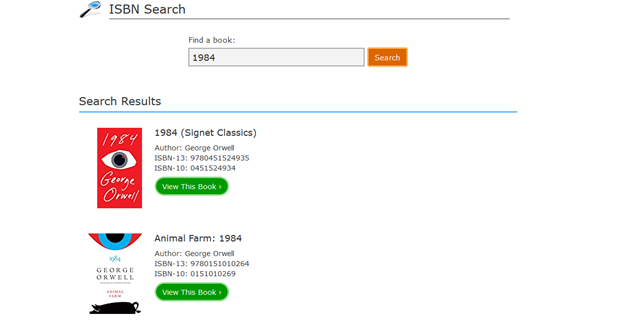
Conclusion
ISBN’s are a key brick in the foundation of your self-publishing business. Having your ISBN’s registered and attached to your books will make selling to the various libraries and bookstores much easier. We cover how to do that in a later post.
ISBN Links & Resources
International ISBN Agency
https://www.isbn-international.org
ISBN.org by Bowker
https://www.isbn.org/faqs_general_questions
Bowkerlink Publisher Access System
https://commerce.bowker.com/corrections/common/home.asp
Bowker Identifier Services
U.S. Copyright Office
ISBN Set Up Guide
